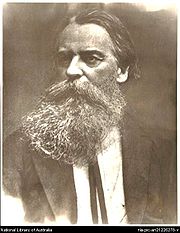|
|
|
|
| Thomas Baines: from Childhood to the grave |
|
| The are many ways and aspects to describe the life and times of Thomas Baines {1822-1875}! We have chosen to use the words of Sir Henry Rawlinson, the then President of the Royal Geographical Society, which he delivered during his Annual Address on the 22nd May, 1876......: |
 |
Thomas Baines, the well-known African traveller and painter of African scenery, died at Durban, Natal, on the 8th May, 1875, whilst preparing for another of his numerous expeditions into the unexplored interior of the Continent. He was a man of marked individuality of character, a born artist and explorer, a lover of wild life, and skilled in all the shifts and resources of an explorer's career. Few men were so well endowed with these and other qualifications for successful African travel, and perhaps none possessed greater courage and perseverance, or more untiring industry than Baines.He was born at King's Lynn, in Norfolk, in 1822, the second son of a master mariner of that place. |
|
After receiving such an education as the views and circumstances of his parents admitted, he was placed with a coachbuilder to learn the art of heraldic painting on carriage-panels; but a strong, innate love of art soon led him to more elevated subjects, and he devoted much of the leisure time of his youth to sketching marine subjects from nature along the coasts of his native county. His ardent imagination fired him with a desire to see foreign countries, and in 1842 he left England for the Cape of Good Hope.
|
| It was in Cape Colony and in the neighbouring countries of South Africa that he was destined to pass the greater portion of his subsequent life; and it was here that he became better known even than in his native country. In fact, few men were thought so much of, or talked so much of, for many years in our South African Colonies as the artist-traveller, Thomas Baines. |
| |
|
| His extreme unselfishness and willingness to oblige, his prolific pencil, ready for anything—African landscape, scenes of native war, animal and indeginous people's life, or portraits of his friends—and his fluent pen, kept him continually before the Colonial public and made him popular. It is to be remarked also that many friendships which he formed in the Colonies were kept with constancy to the end of his life. In 1846-7 he left Cape Town and proceeded to the then nearly unknown regions to the north of the Colony for the purpose of sketching the scenes and incidents of the indeginous wars then waging. Again, in the subsequent wars of 1851-3, he was busily engaged on the frontier in similar work, he having been attached to General Somerset's staff during the campaigns, through the intervention of his faithful friend, Mr. R. White. Several hundred sketches, displaying great vigour and vivid local character, were the results of his labours ; many of which have since been on exhibition with his other works, in London and Dublin. On the 6th November, 1861, he was present at the action with rebel Hottentots at Water Kloof, when Colonel Fordyce, of the 74th Regiment, was killed, and in fact, Baines, in his desire to sketch faithfully scenes of actual battle, generally strove to be in the front, and he was rich in anecdotes of adventure and narrow escape in the presence of the enemy............. |
|
|
| |
| |
|
| If you feel this is not an
accurate profile and you have a more accurate one, or
you have a clarification , you can submit your version of the Profile here |
|
|
|
|
| |
|